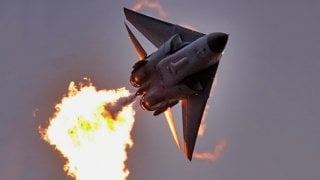F-111 Aardvark: Vietnam and Gulf War Sensation (It Almost Killed Qaddafi)
The General Dynamics F-111 Aardvark was a low-altitude strike plane born out of a shotgun wedding between competing Air Force and Navy requirements—with Defense Secretary McNamara as the minister.
However, a Raven piloted by James Denton went on to score one of the most unusual aerial victories of the conflict.
On the opening day of Desert Storm, Denton’s EF-111 was skimming just 400 feet above the ground in the morning darkness, leading the way for a strike package of F-15E fighter bombers with F-15C fighters for top cover. While passing the H3 airfield, an Iraqi Mirage F1 fighter fell in behind the Raven. Denton rolled sharply to the left, then to the right and pumped out chaff, evading a heat-seeking missile. As the Iraqi pilot attempted to match the Raven’s evasive maneuvers, he lost situational awareness and his jet slammed into the ground.
Thus, the unarmed Raven variant scored the only aerial victory for the F-111 “fighter”.
As Iraqi defenses thinned out, the Aardvarks were redirected to hit ground forces. The F-111F’s Pave Tack system proved effective at “tank plinking”—identifying Iraqi armored vehicles with its infrared scanner, and then precisely directing a laser-guided bomb on top of it. Over 1,500 Iraqi vehicles were “plinked” by F-111s.
F-111s also targeted the oil manifold Saddam had sabotaged, stopping the flow of petroleum polluting the Persian Gulf.
Desert Storm was the Aardvark’s last hurrah. The F-111 was finally withdrawn from U.S. Air Force service in 1998. Though the Aardvark was good at its job, it had high maintenance costs, and the Air Force judged that its fleet of F-15E Strike Eagles could take care of shorter-range attack missions, while B-1 bombers could handle longer range strikes.
The EF-111, however, had no replacement in the Air Force inventory. It was left to Navy and Marine EA-6B Prowlers—and today, EA-18G Growlers—to fulfill the jamming role.
Pigs of the Pacific
The F-111 remained in service with the Australian Air Force until 2010, where it was affectionately known as the ‘Pig.’ Starting with a batch of 24 F-111Cs received in 1973, the Australians acquired an additional 15 FB-111s and four F-111As. Though never used in combat, the F-111s gave Australia the ability to project military force across the vast distances of the Pacific Ocean, enhancing its diplomatic clout.
Pigs were the pride of Australian air shows, where they frequently performed a maneuver in which fuel was dumped and ignited with the afterburners, known as the Dump and Burn. Australia upgrades its F-111s to use anti-shipping missiles and converted four into reconnaissance aircraft. Due to their high operating costs, however, they were finally replaced by twenty-four F-18F Super Hornets.
While the F-111 has been retired, a similar aircraft remains in use today. The Russian Sukhoi Su-24 Fencer was conceived shortly after the F-111, and is remarkably similar in appearance and role, down to the swing wings. Not quite the Aardvark’s equal in terms of range, speed or weapons load, nearly three times more Su-24s were produced and over three hundred serve on today in various world air forces. They have been actively used in combat over Syria, Chechnya, Libya, Afghanistan and Ukraine. A Russian Su-24 attacking Syrian rebels was shot down in 2015 by a Turkish F-16, causing a major diplomatic incident.
About the Author
Sébastien Roblin holds a Master’s Degree in Conflict Resolution from Georgetown University and served as a university instructor for the Peace Corps in China. He has also worked in education, editing, and refugee resettlement in France and the United States. He currently writes on security and military history for War Is Boring.

